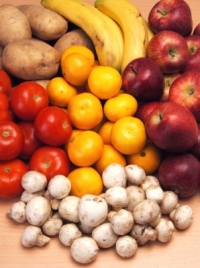|
10 EASY steps to grow your own organic food garden
Organic food is, even today, still surrounded by controversy. If nature had its way, there would be an ecological balance.... Produce would not be sprayed with synthetic pesticides, synthetic fertilizers would not be added to the soil, and hormones and antibiotics would not be fed to animals. Well OK, you may say, what can I, as a consumer do to refrain from being part of all these practices? Your own little organic food (vegetable) garden is the perfect way to sidestep all the "progress" made by the human race. Organic food gardening entails the use of natural predators to control pests, crops are alternated and inedible parts of the crops are used for compost or mulch, to name a few. It is all about a system of interdependent and sustainable communities of plants, animals, soil and people. To show you how easy and gratifying this venture can be, I will teach you in 10 EASY steps to grow a healthy, wonderful, organic vegetable garden! OK, here we go: 1. Collect rubbish that will be good for the soil: Food and vegetable waste, mealie cobs, food scraps, dead flowers and plants, weeds, leaves, grass-clippings, veld grass, bones, feathers, egg shells, torn-up cardboard and newspaper. Wood ash, not coal ash, which is not fresh, can also be added. Bad rubbish: Plastic, rubber, glass, old batteries, electronic waste.
2. Measure out a bed roughly the size of a standard door (2 metres x 1 metre). Make sure, before you start, that you have enough rubbish to half-fill the trench.
3. Dig the bed to a depth of about 50 centimetres, about knee-deep, to make a trench. Heap the darker topsoil on one side and the subsoil on the other side.
4. Half-fill the trench with the good rubbish. Mix the cardboard and paper, broken into pieces, with the food waste.
5. Wet the rubbish - it will decompose faster.
6. Cover the waste immediately with 15 centimetres of subsoil, and follow with the topsoil.
7. Cover the filled trenchbed with MULCH. Mulch is very important - it keeps the soil cool and moist. Mulch is a protective covering made up of dry grass, dead leaves, sawdust, stones, etc. Mulch decomposes, and will have to be replenished regularly.
8. Plant your seeds (or seedlings) immediately. (Nurseries and gardening outlets will be able to supply you with the correct seeds or seedling for the season): * Make partings and a shallow furrow in the mulch across the bed, with your hands or a stick, about 20 centimetres apart. * Sow seeds carefully, not too thickly, and cover them with a little fine, dry soil. Press the soil down gently but firmly. Do not cover with mulch at this stage (only when they are 5 cm tall).
9. Water carefully. Use a watering can, not a hose pipe. Water the seeds daily for the first 10 days.
10. Protect your garden: Put a fence around your garden using either sticks, stones or wire. You can also place a net over the bed, or plant a live fence using thorny plants.
Some more useful tips: # Looking after your soil: Do not stand on the soil, this makes it hard and squeezes out the air. Do not dig or turn the soil, it is not necessary - the earthworms will do this for you!
# Do succession planting: Plant your second bed four weeks after the first, your third another four weeks later, until you have at least four beds. This will give you a continuous supply of fresh vegetables. # Don't leave empty spaces in a bed. Replant empty rows as soon as you have harvested a crop. In other words, apply crop rotation. # Liquid manure is a good plant tonic, for when the plants are established, and at least 10 cms tall: Collect dung, put enough to fill a 1 litre carton into a bucketful of water, leave for three days. For very young plants, use one bottle of the mixture to 40 bottles of water, but wet the soil first. For older plants, use a 1 to 20 ratio, and also wet the soil first.
OK, now it's over to you. If you have kids, or grandkids, just imagine how they will love this organic food garden project ..... and I am sure you will enjoy growing your own vegetables as much a I do!
|





